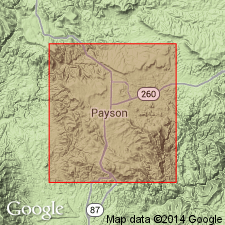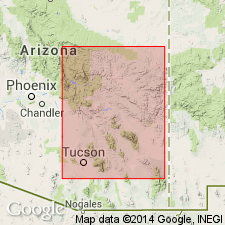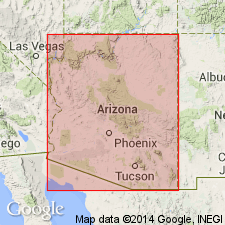
- Usage in publication:
-
- Sycamore Creek sandstone
- Modifications:
-
- Original reference
- AAPG geologic province:
-
- Basin-and-Range province
Summary:
Pg. 7, 12-13. Sycamore Creek sandstone. Name proposed by A.A. Stoyanow in unpublished manuscript. The formation is generally dull reddish brown in color, although some buff-colored beds are present. Is made up of a coarse quartz sand cemented chiefly by oxides of iron and carbonate of lime. Cross-bedding is locally common, and then the stratification is not well defined. Traversed by numerous joints. Pebbly layers common. Is conformably overlain by thin-bedded flaggy limestones containing fossils identified by Stoyanow as Upper Devonian. Occurs as isolated remnants south and southeast of Payson, while to north is a large area partly overlain by Redwall limestone. Upper part has been largely removed by erosion, and where overlain by Redwall limestone [Mississippian] the thickness is seldom over 150 feet. Contains fossil fishes identified by Stoyanow as undoubtably Upper Devonian. Rests unconformably on pre-Cambrian diorite and in places on older rocks. On recent map of Arizona is classified as Tapeats sandstone (Upper Cambrian). Age is Late Devonian.
Source: US geologic names lexicon (USGS Bull. 896, p. 2102).

- Usage in publication:
-
- Sycamore Creek formation
- Modifications:
-
- Overview
- AAPG geologic province:
-
- Basin-and-Range province
Summary:
Pg. 311-315. Sycamore Creek formation. Three cliff-forming sandstones, separated by beds of reddish mottled sandstone, pink-white quartzitic sandstone, and compact pink sandstone; some beds of gray limestone. Thickness 125 to 324 feet. Best exposed at Sycamore Creek, a tributary of East Verde River. Overlian by Devonian limestone. Rests on granite. Age is Devonian.
Source: US geologic names lexicon (USGS Bull. 896, p. 2102).

- Usage in publication:
-
- Sycamore sandstone member
- Modifications:
-
- Revised
- AAPG geologic province:
-
- Basin-and-Range province
Summary:
In 1936 Stoyanow gave further description of this unit and changed its name to Sycamore sandstone member of Jerome formation, as explained under 1936 entry of Jerome formation. [See Jerome.]
Source: US geologic names lexicon (USGS Bull. 896, p. 2102).

- Usage in publication:
-
- Sycamore sandstone
- Modifications:
-
- Revised
- AAPG geologic province:
-
- Basin-and-Range province
Summary:
Pg. 228. Sycamore sandstone designated the middle part of the Jeromian series (new). Underlies East Verde limestone (new); overlies Vecol limestone (new). Thickness 75 feet. Age is Late Devonian.
Source: US geologic names lexicon (USGS Bull. 1200, p. 3797).
For more information, please contact Nancy Stamm, Geologic Names Committee Secretary.
Asterisk (*) indicates published by U.S. Geological Survey authors.
"No current usage" (†) implies that a name has been abandoned or has fallen into disuse. Former usage and, if known, replacement name given in parentheses ( ).
Slash (/) indicates name conflicts with nomenclatural guidelines (CSN, 1933; ACSN, 1961, 1970; NACSN, 1983, 2005, 2021). May be explained within brackets ([ ]).

